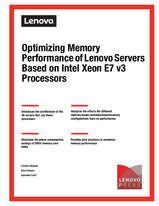Top
Updated
4 Apr 2016Form Number
LP0048PDF size
32 pages, 303 KBSubscribed to LP0048.
Thank you for your feedback.
Abstract
This paper examines the architecture and memory performance of Lenovo System x and Flex System X6 platforms that are based on the Intel Xeon E7-8800 and E7-4800 v3 processors. The performance analysis in this paper covers memory latency, bandwidth, and application performance. In addition, the paper describes performance issues that are related to CPU frequency, memory speed, and population of memory DIMMs. Finally, the paper examines optimal memory configurations and best practices for the Lenovo X6 platforms.
Table of Contents
- Introduction
- System Architecture
- Memory Performance
- Measurement Configuration
- Memory Modes
- Memory Speed
- DIMM Types
- Ranks per Channel
- Memory Population and Balance
- Different DIMM Capacities and RPC Effect on Memory Throughput
- Balancing Memory Population on X6 Platforms
- Power Consumption
- Best Practices
- Conclusion
- Authors
Change History
Changes in the April 4 update:
- Grammar & spelling corrections
Related product families
Product families related to this document are the following:
Configure and Buy
Please select a locale

